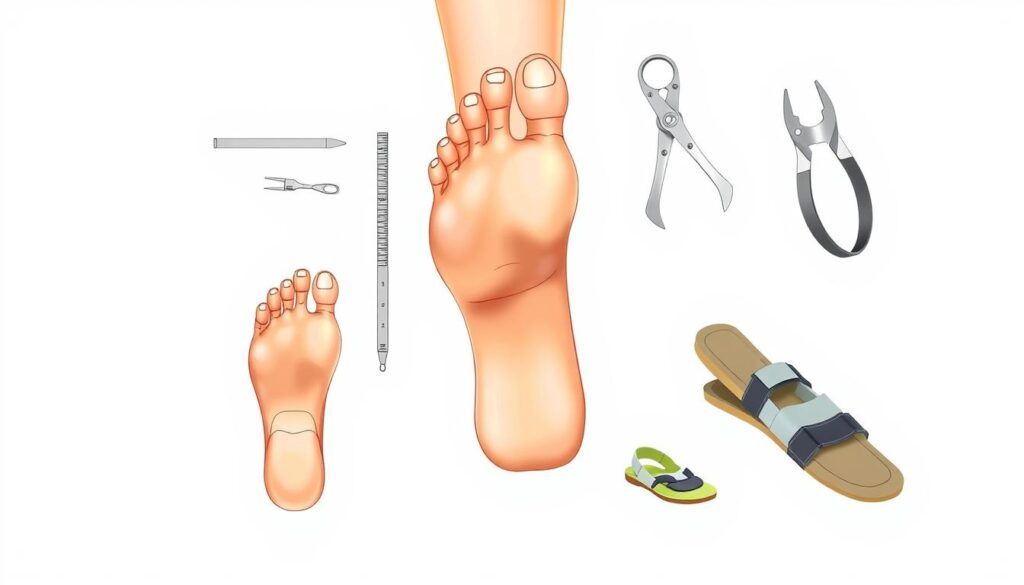Flatfeet, or fallen arches, is a common foot problem affecting many people. It can cause foot pain, but you might not know why. Learning about flatfeet can help you manage discomfort and keep your feet healthy.
Flatfeet occur when your foot’s arch flattens during weight-bearing activities. This condition can start in childhood or develop later in life. Genetics play a big role in flatfeet.
If your parents have flat feet, you’re more likely to have them too1. Doctors use X-rays, MRI, and ultrasound to check how flat your feet are2.
They also look at your feet and use special imaging to understand your foot structure1. This helps them figure out the best way to help you.
Key Takeaways
- Flatfeet can develop from genetics, injury, or aging
- Not all individuals with flatfeet experience pain
- Multiple diagnostic tools help evaluate the condition
- Treatment options range from orthotic devices to surgery
- Professional medical advice is crucial for management
Understanding Flat Feet and Their Impact
Flat feet, or pes planus, is common in people of all ages. Your foot’s arch is crucial for walking and distributing body weight3. Some people may experience discomfort, while others might not face any issues.
The human foot can have different types of flat feet. Each type has its own unique features. Knowing these differences helps manage symptoms and seek proper care.
Types of Flat Feet Conditions
- Flexible Flatfoot: Typically develops during childhood and may resolve naturally4
- Rigid Flat Feet: Often appears in adulthood and can limit foot mobility5
- Overpronation: A condition where the foot rolls inward excessively while walking
Common Signs and Indicators
Spotting low arch signs early can help address potential problems. Look out for these common indicators:
- Pain in the ankle, arch, or foot
- Muscle fatigue and leg cramps
- Changes in walking patterns
- Visible flattening of the arch when standing3
“Not all flat feet require medical intervention. Many people live without experiencing significant discomfort.” – Foot Health Expert
Obesity, foot injuries, aging, and certain medical conditions can lead to flexible flatfoot5. Knowing these factors helps you take care of your feet.
Causes and Risk Factors of Flatfeet
Flatfeet develop through various complex mechanisms that impact your mobility. Some people inherit a collapsed arch from their family. Understanding these causes can help you manage your foot health better6.
- Obesity and excess body weight
- Diabetes
- Rheumatoid arthritis
- Foot or ankle injuries
- Aging process
Children have unique patterns with flatfeet. Boys are more likely to develop this condition7. Kids under 9 show different chances of having flatfeet7.
| Age Group | Flatfoot Risk |
|---|---|
| Under 6 years | Higher risk (OR = 3.11) |
| 6-9 years | Moderate risk (OR = 0.54) |
Urban living, lack of exercise, and certain shoes can affect posterior tibial tendon dysfunction7. Knowing these risks helps you take care of your feet better.
Your feet are the foundation of your body’s movement – understanding their structure is key to overall wellness.
Most people with flatfeet have few symptoms and can live normal, healthy lives. Proper management is key to maintaining foot health6.
Conclusion
Flat feet don’t have to mean constant discomfort. Your management approach can greatly affect your foot health and mobility8. Orthotics and arch supports can offer relief and improve daily functioning, according to foot health research9.
Arch variations are common throughout life. About 23% of adults have a collapsed medial longitudinal arch. Only 4% of children keep a flat foot posture beyond age 109.
Many people manage their condition well with proper care. If you have ongoing foot pain, see a podiatrist. They can help create a personalized treatment plan.
Arch supports and custom orthotics can provide stability and reduce discomfort. They may also prevent future problems8. Taking action now can improve your long-term foot health and overall well-being.
FAQ
What exactly are flatfeet?
What are the different types of flatfeet?
What causes flatfeet?
What are the common signs of flatfeet?
When should I be concerned about flatfeet?
What treatment options are available for flatfeet?
Can children outgrow flatfeet?
Are flatfeet hereditary?
Source Links
- Flat Feet: Causes, Symptoms, and Treatments – https://integrityfootandankle.com/understanding-flat-feet-causes-symptoms-and-treatments/
- Flatfeet – Diagnosis and treatment – https://www.mayoclinic.org/diseases-conditions/flatfeet/diagnosis-treatment/drc-20372609
- Flatfeet – Symptoms and causes – https://www.mayoclinic.org/diseases-conditions/flatfeet/symptoms-causes/syc-20372604
- Flat feet: Symptoms, exercises, diagnosis, and treatment – https://www.medicalnewstoday.com/articles/168608
- Flat Feet Explained | Insoles for Flat Feet | Superfeet – https://www.superfeet.com/blogs/foot-health-podiatry/flat-feet-explained
- Flat Feet – https://www.chop.edu/conditions-diseases/flat-feet-in-children
- Risk Factors of Flatfoot in Children: A Systematic Review and Meta-Analysis – https://pmc.ncbi.nlm.nih.gov/articles/PMC9319536/
- Flat Feet: A condition that may cause Musculoskeletal health problems – https://acc.vn/en/flat-feet-a-condition-that-may-cause-musculoskeletal-health-problems/
- Flexible flatfoot – PMC – https://pmc.ncbi.nlm.nih.gov/articles/PMC5175026/
